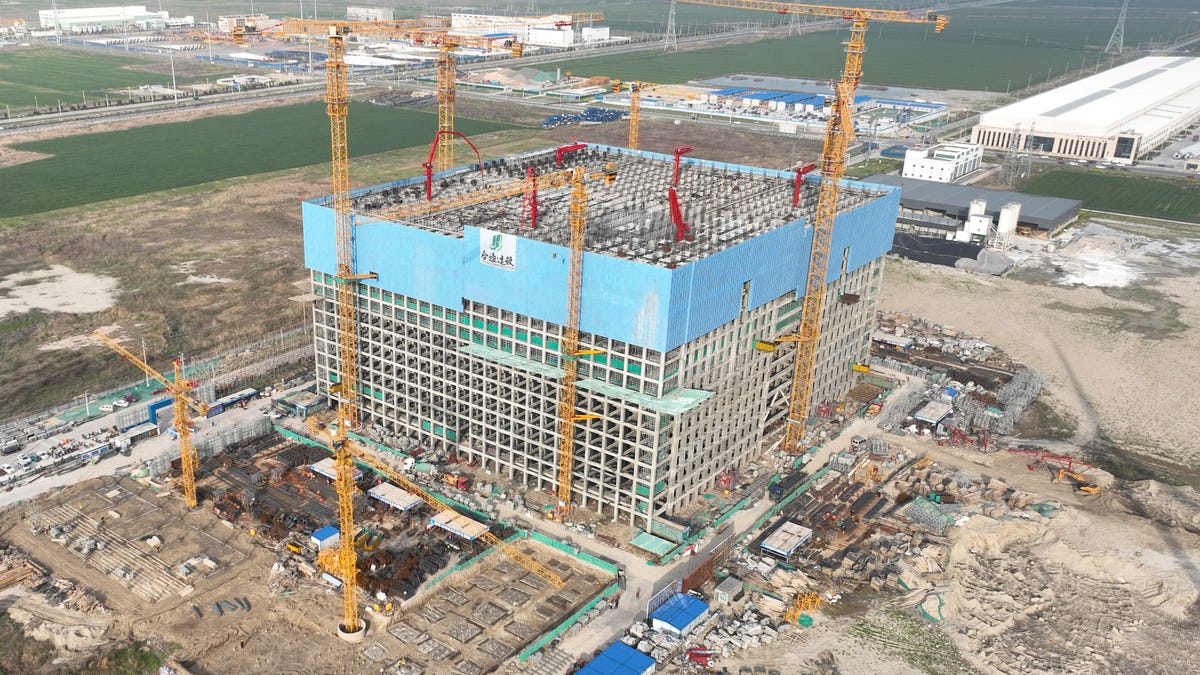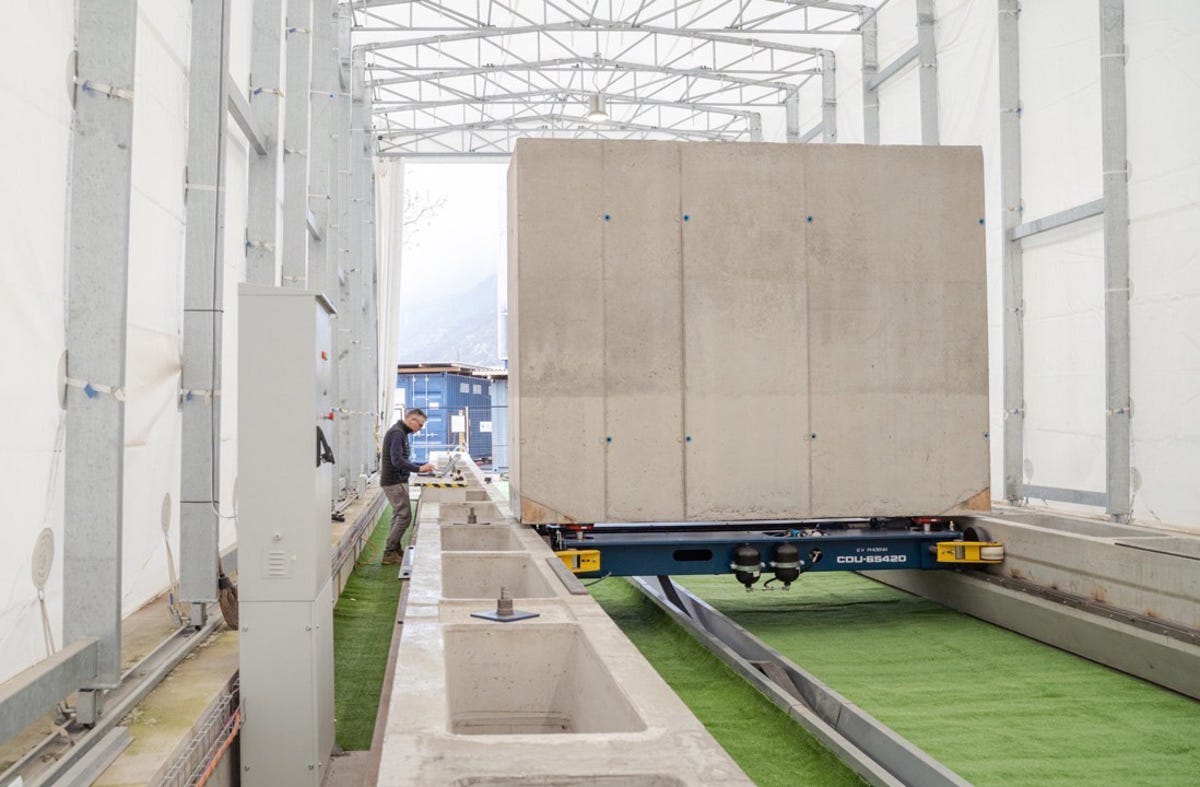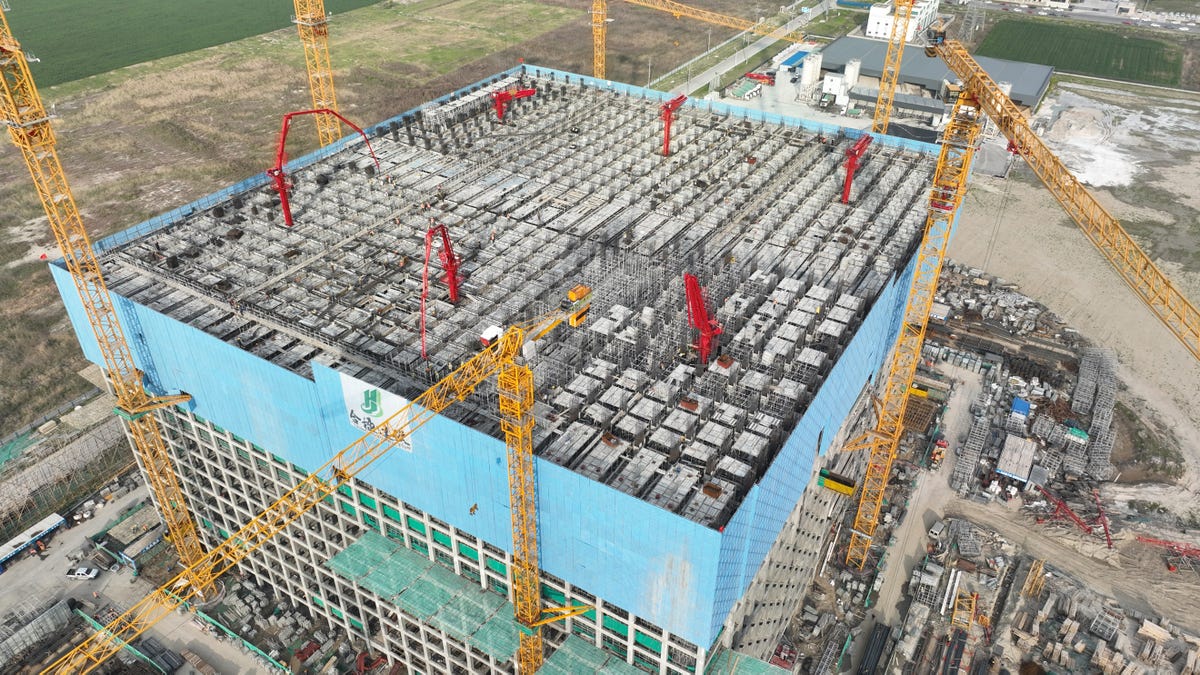
this is an odd idea, but certainly shows us that you really have to build to discover if something is actually viable or not.
this reminds me of our cooling tower style athmospheric pressure stack that also gets a natural base power boost from the Coriolas effect just because the earth is spinning. suddenly we have 200 tons on air pads spinning and driving turbines even before you open up hte vaccuum driven air flow.
that power could easily be collected using gravity lifts as well. all this is pure Newton and demands only classic engineering.


How These 24-Ton Bricks Could Fix a Huge Renewable Energy Problem
This startup could solve a core issue with renewable energy.
Stephen Shankland
https://www.cnet.com/home/energy-and-utilities/how-these-24-ton-bricks-could-fix-a-huge-renewable-energy-problem/?ref=refind
Stephen Shankland has been a reporter at CNET since 1998 and writes about processors, digital photography, AI, quantum computing, computer science, materials science, supercomputers, drones, browsers, 3D printing, USB, and new computing technology in general. He has a soft spot in his heart for standards groups and I/O interfaces. His first big scoop was about radioactive cat poop.
Expertiseprocessors, semiconductors, web browsers, quantum computing, supercomputers, AI, 3D printing, drones, computer science, physics, programming, materials science, USB, UWB, Android, digital photography, scienceCredentialsI've been covering the technology industry for 24 years and was a science writer for five years before that. I've got deep expertise in microprocessors, digital photography, computer hardware and software, internet standards, web technology, and other dee
7 min read
Energy Vault's first large-scale gravity storage system is under construction in China and should be complete by June.Energy Vault
Imagine a gigantic brick, packed full of compressed dirt. As big as a pickup truck but -- at 24 tons -- about five times heavier. An elevator powered by solar panels or wind turbines hoists it over 300 feet up the side of a huge building. A trolley stows it inside, but it's not alone. An automated system lifts and stores hundreds more bricks, like giant Pez candies, as the sun shines and the wind blows.
Now imagine the building's control system lowering those hundreds of bricks one by one, spinning electrical power generators in the process. They drop down every evening just as demand for power peaks but solar panel output fades away.
In effect, the brick-filled building is a giant battery that stores energy with gravity instead of chemistry.
Gravity batteries are a potentially important solution to a critical problem with the green energy revolution: making sure electricity is available when we need it, not just during the times when sun and wind supply it.
And it isn't just an idea. With two sites under construction — one in Rudong, China, just north of Shanghai, and the other in Snyder, Texas, about 250 miles west of Dallas — startup Energy Vault will begin seriously testing the viability of the gravity storage technology. An earlier pilot generated 5 megawatts of power, but these two facilities and expected successors will show whether gravity storage is economical and efficient enough to work at large scale.
Power when the sun goes down
You may think putting solar panels on your roof will help fight climate change, but without some form of energy storage in your home or on the grid, you'll likely rely on carbon dioxide-spewing gas and coal power plants to run your home's lights, TV and dishwasher as the sun sets.
Energy Vault tested its technology at a smaller scale in Switzerland, where the 170-person company is headquartered. Its two EVx systems under construction are much bigger. The Chinese system, built for waste management and recycling company China Tianying, is in a 400-foot-tall building and will have an energy storage capacity of 100 megawatt-hours. That's enough to power 3,400 homes for an entire day, and the system should be complete by June. The Texas system, in a 460-foot-tall (but narrower) building, will provide power company Enel with 36MWh of capacity.
Solar panels and wind turbines now generate power more cheaply than coal and natural gas plants, making them a clear choice in the push to replace fossil fuels. Solar power costs dropped 83% from 2009 to 2023 and wind costs dropped 63% over the same period, according to tracking from investment advisory and asset management firm Lazard. But in many parts of the country, new solar panels often just supply a glut of power during the middle of the day without helping in the evenings.
The mismatch between power production and power usage is responsible for the infamous "duck curve," a graph with a birdlike shape showing the disparity increasing with each passing year. That disparity makes it hard for utilities to adjust to rapid changes in demand and means fossil fuel powered sources like natural gas "peaker plants" supply power in the evenings.
"If we're ever going to wean ourselves more and more off of fossil fuels and replace that with renewable generation that's intermittent, the only way to solve that is storage," said Energy Vault Chief Executive Robert Piconi.
Energy Vault isn't alone. Another startup, Gravitricity, has built a 250-kilowatt demonstration system and is planning a larger 4MW to 8MW system in an unused mine shaft.
Energy storage cost is key
Gravity storage is just one way to smooth out the spurts of wind and solar. Big batteries like Tesla Megapacks — industrial-scale versions of the same batteries that power your phone or electric vehicle — are increasingly common on the power grid. "Pumped hydro," an older form of gravity battery that pumps water to an uphill reservoir then generates power when it flows back downhill, has been used for decades but is attracting new interest. Other methods include filling underground chambers with compressed air, storing hydrogen that later powers fuel cells, and developing different types of batteries, like zinc batteries and flow batteries.

Energy Vault's EVx system hoists these 24-ton bricks up hundreds of feet to then recapture that potential energy by lowering them when power is needed. The bricks are made of compressed dirt with a polymer matrix and are shuttled within the system using a trolley setup beneath the bricks.Energy Vault
Cost will be a major factor in determining what storage technology prevails, including initial manufacturing and continuing operations.
"At the end of the day it will all come down to price," said Selene Law, an energy analyst at consulting firm Cleantech Group. And for gravity storage, questions about total cost persist, she said.
Indeed, a 2022 US Department of Energy study concluded that gravity energy storage is relatively expensive in smaller installations. Where it's most economical is in high-capacity systems that generate power for relatively long periods of time — 10 hours or more.
Energy Vault hasn't disclosed the cost of the two systems under construction, but it agrees the technology offers advantages for long-duration power needs.
Longevity is a cost factor over the lifetime of the plant. Batteries lose capacity with use, the same way your phone doesn't run as long after a couple of years of ownership, but gravity storage components, like pulleys and generators, can be maintained.
"The key of our value proposition is the lack of degradation of the storage medium," said Marco Terruzzin, a mechanical engineer and Energy Vault's chief commercial product officer. "We provide a guarantee on the system for at least 35 years."
Though Energy Vault has taken only its first steps in proving the technology's value, two customers have concluded it's worth paying for today. And the 100MWh system in China is only the first there, the company said. The country expects to fund another 4GWh to 6GWh of capacity later — an increase of 40 to 60 times the initial plant.
How Energy Vault's EVx works
Energy Vault's gravity EVx storage system is a giant rectangular building that largely runs automatically. Here's how it works.
The bricks at the heart of the system each measure 3.5 by 2.7 by 1.3 meters (about 11 by 9 by 4 feet) and weigh 24 metric tons. They're made of 99% compressed dirt with some water and a polymer mixture to stabilize it using a recipe from Mexican building materials company Cemex. They're 2.4 times denser than water and about the same as concrete.

Energy Vault's first large-scale gravity-based energy storage system in Rudong, China, is hundreds of feet tall.Energy Vault
The bricks are stored side by side within the building, like dominoes jammed together. Before they're raised or lowered, a trolley system hefts each brick and trundles it to the elevator.
Bricks are housed on the top eight levels of the building to store energy and drop down to the corresponding lower eight levels to generate power. Each brick, descending at 1.9 meters per second (6.23 feet), turns out about a megawatt, Terruzzin said. That's about enough to power 2,000 refrigerators.
Once each brick reaches the bottom, it's robotically transferred to the trolley system and moved toward the center of the building.
Making the building longer, with longer trolley tracks, means more bricks can be stored for more hours of power generation. Making the building wider, with more elevators, means the system can generate a higher peak power rate.
As for efficiency, Energy Vault guarantees EVx systems will generate at least 80% of the energy required to lift the bricks and scoot them around, including factors like friction. That overall efficiency is comparable to pumped hydro.
Key to Energy Vault's business is the control system that decides when and where to position the bricks for optimal storage and even energy output.
"While we're decelerating one at the bottom, the next one is loading and beginning to accelerate," said Bill Gross, Idealabs chief executive and Energy Vault co-founder, speaking at the Techonomy Climate conference in March.
The maximum output will be 25MW at the China system and 18MW at the Texas system.
Overcoming gravity storage challenges
Energy Vault settled on its current design after evaluating several other options — gravel in carts, water in tanks, concrete blocks hanging from cranes.
The EVx is designed to overcome problems with those designs. It's weatherproof, which means bricks don't get wet or blown around, for example.
Energy Vault isn't putting all its energy storage eggs in the gravity basket. A contract with California's Pacific Gas and Electric, could result in a system to power the city of Calistoga for up to 48 hours with a combination of hydrogen fuel cells and batteries. Hybrid systems with gravity and battery storage also make sense, since batteries can respond very rapidly to increase or decrease, Terruzzin said.
With Energy Vault's plants headed into production, we should start getting a better idea this year how well gravity storage really works. "This will be a crucial year for Energy Vault," Cleantech Group's Law said. "The proof will be in the pudding."
The company isn't profitable, reporting a net loss of $78 million for 2022 on revenue of $146 million. And its stock has slumped by 89% over the last year, a fate many startups suffered with economic troubles and skeptical investors.
Energy Vault's Piconi is convinced the company is on the right path toward making energy storage more economical, though.
"Wind and solar are so much cheaper than fossil fuels now... The problem is storage is typically 10 to 15 times that," Piconi said. "We have to get there."
Correction, 9:26 a.m. PT: A previous version of this story misstated Energy Vault's 2022 financial results. It reported a net loss of $78 million on revenue of $146 million.First published on April 21, 2023 5:00 a.m. PT
No comments:
Post a Comment